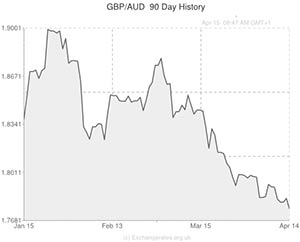
Overnight the Australian Dollar softened against the Pound as investors digested the content of minutes from the April Reserve Bank of Australia policy meeting.
While the minutes were comparatively upbeat when it came to Australia’s economic performance, they did warn that a strong Australian Dollar exchange rate could weigh on domestic growth and intimated that interest rates would remain low for the foreseeable future.
According to one strategist; ‘The RBA is showing a little bit more interest in the currency. Perhaps they could have construed as the RBA pushing the line on the currency.’
The minutes stated that an impressive improvement in dwelling investment was likely and that ‘there was some evidence that consumer demand had strengthened a little.’
However, the minutes also warned; ‘However, many businesses appeared to be waiting for an increase in current demand to occur before they were willing to increase investment spending’.
The minutes saw the Australian Dollar edge away from a five-month high against its US counterpart and lose ground against Sterling.
Before the RBA report was released the South Pacific currency had been supported by strong US retail sales data.
Another factor piling pressure on the ‘Aussie’ is the fact that China’s growth data (scheduled for publication tomorrow) is expected to confirm that the world’s second largest economy is faltering.
The GDP report is forecast to show that growth climbed by 7.3 per cent in the first quarter of 2014 on an annual basis.
This would be a drop from annual expansion of 7.7 per cent in the fourth quarter.
China’s industrial production report, also due out tomorrow, is forecast to show a year-on-year increase of 9 per cent in March while retail sales climbed by 11.9 per cent.
Ukraine-inspired risk aversion also pushed investors away from higher-risk assets like the ‘Aussie’ and the AUD to GBP pairing ended local trading weaker.
The Australian Dollar was also weaker against the Euro.
But on Wednesday Sterling came under pressure following the publication of influential British data.
As the European session progressed the Pound slipped slightly as the UK’s consumer price index confirmed that the nation’s inflation rate slowed to a four and a half year low last month.
While the Bank of England’s inflation target remains 2 per cent, consumer prices climbed by just 1.6 per cent in March – down from the annual increase of 1.7 per cent recorded in February.
Month-on-month, prices increased by 0.2 per cent, in line with expectations.
The Pound extended previous declines against the US Dollar after the report was published but remained a little stronger against the ‘Aussie’.
Overnight additional GBP to AUD movement could be sparked by Australia’s Westpac Leading Index. Investors will also be looking ahead to UK employment figures.
Australian Dollar (AUD) Exchange Rates
[table width=”100%” colwidth=”50|50|50|50|50″ colalign=”left|left|left|left|left”]
Currency, ,Currency,Rate ,
Australian Dollar, ,US Dollar, 0.9383,
,US Dollar, 0.9383,
Australian Dollar, ,Euro, 0.6803,
,Euro, 0.6803,
Australian Dollar, ,Pound, 0.5617,
,Pound, 0.5617,
Australian Dollar, ,New Zealand Dollar, 1.0864,
,New Zealand Dollar, 1.0864,
US Dollar, ,Australian Dollar, 1.0656,
,Australian Dollar, 1.0656,
Euro, ,Australian Dollar, 1.4704,
,Australian Dollar, 1.4704,
Pound Sterling, ,Australian Dollar, 1.7811,
,Australian Dollar, 1.7811,
New Zealand Dollar, ,Australian Dollar, 0.9206,
,Australian Dollar, 0.9206,
[/table]

Comments are closed.